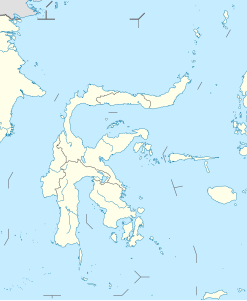Caves in the Maros-Pangkep Karst
| Caves in the Maros-Pangkep Karst
|
||
|---|---|---|
|
Handprints in the Leang Pettakere cave |
||
| Location: | Bantimurung-Bulusaraung National Park , Maros Governorate , Sulawesi Selatan , Sulawesi , Indonesia | |
|
Geographic location: |
4 ° 58 '52 " S , 119 ° 37' 58" E | |
|
|
||
| Type: | Karst cave | |
In the caves in the Maros-Pangkep Karst on Sulawesi , around 40,000 year old cave paintings were discovered. The paintings are about as old as the oldest of their kind in Europe (for example in the El-Castillo cave ). The murals in the caves show handprints and images of animals such as deer boar , Sulawesi pustular pig and anoa .
The Maros-Pangkep Karst is located in the Bantimurung-Bulusaraung National Park in the Maros administrative district in the Sulawesi Selatan Province, Indonesia. The park is about 50 km north of Makassar. The area includes the limestone mountains of Maros Pangkep, the second largest karst region in the world after southeast China. The karst region comprises 286 caves, including 16 prehistoric caves in Maros Governorate and 17 prehistoric caves in Pangkep, Bone Governorate.
The limestone cave Leang Timpuseng together with other caves (Jarie, Buragayya, Lompoa, Gua Jing, Sampeang, Pettakere, Pettae, Jane, Saripa and Karrasa) form a prehistoric site. It is located near the town of Maros .
A handprint in Leang Timpuseng Cave is estimated to be at least 39,900 years old. There is also a 50 cm large image of a deer boar in this cave. It is estimated to be 35,400 years old. The works of art were dated using the uranium-thorium dating of the sintering on the paintings. There are 26 red and white prehistoric handprints in the entrance area of the Leang Pettakere cave. They are so far undated.
On a rock wall in the Leang Bulu 'Sipong cave (near Pangkep) there are depictions of several animals and animal-human hybrid beings ( therianthropes ) made with dark red pigment. In one scene, several small hybrid creatures (4 to 8 cm long) are connected with ropes or spears with a large anoa (74 by 29 cm). The paintings were examined based on the uranium-thorium dating of the overlying speleothems . The age of the paintings is given as at least 43,900 years. According to Aubert, this is the oldest figurative work of art in the world. The wall paintings, discovered by Pak Hamrullah in 2017, were dated and described in more detail in 2019 by Maxime Aubert's research team.
In addition to erosion, which may have already destroyed some of the wall paintings, researchers believe that the publication of the finds and the increased interest in visiting the archaeological sites will pose a challenge for those responsible. The caves were already included in the UNESCO tentative list for Indonesia in 2009 .
literature
- M. Aubert, A. Brumm, M. Ramli, T. Sutikna, EW Saptomo, B. Hakim, MJ Morwood, GD van den Bergh, L. Kinsley & A. Dosseto (2014). Pleistocene cave art from Sulawesi, Indonesia. Nature, 514, pp. 223-227 (09 October 2014). doi: 10.1038 / nature13422 .
- Maxime Aubert, Rustan Lebe, Adhi Agus Oktaviana, Muhammad Tang, Basran Burhan, Hamrullah, Andi Jusdi, Abdullah, Budianto Hakim, Jian-xin Zhao, I. Made Geria, Priyatno Hadi Sulistyarto, Ratno Sardi & Adam Brumm (2019): Earliest hunting scene in prehistoric art, in: Nature, Vol. 576, pp. 442-445.
Web links
- Good overview of the sites
- Sulawesi ancient rock art at donsmaps.com
Individual evidence
- ↑ M. Aubert, A. Brumm, M. Ramli, T. Sutikna, EW Saptomo, B. Hakim, MJ Morwood, GD van den Bergh, L. Kinsley, A. Dosseto: Pleistocene cave art from Sulawesi, Indonesia. Nature 514, Oct. 9, 2014; Pp. 223-227. doi: 10.1038 / nature13422
- ↑ David Cyranoski: World's oldest art found in Indonesian cave . nature.com, October 8, 2014; Retrieved October 9, 2014, with video of the cave paintings
- ↑ David Cyranoski: Indonesia: The oldest human art . Spiegel online, October 8, 2014; Retrieved October 9, 2014.
- ↑ a b Indonesian cave paintings 'revolutionized our idea of human art' (English), Deutsche Welle , October 9, 2014
- ↑ Liz Price: Sulawesi cave of hands . In: The Brunei Times . January 20, 2008. Archived from the original on November 29, 2014. Info: The archive link was automatically inserted and not yet checked. Please check the original and archive link according to the instructions and then remove this notice. Retrieved November 16, 2014.
- ↑ Aubert et al., 2014: Pleistocene cave art from Sulawesi, Indonesia, Nature, 514, 223-227
- ↑ Aubert et al., 2014: Pleistocene cave art from Sulawesi, Indonesia, Nature, 514, 223-227
- ↑ Maxime Aubert, Rustan Lebe, Adhi Agus Oktaviana, Muhammad Tang, Basran Burhan, Hamrullah, Andi Jusdi, Abdullah, Budianto Hakim, Jian-xin Zhao, I. Made Geria, Priyatno Hadi Sulistyarto, Ratno Sardi & Adam Brumm: Earliest hunting scene in prehistoric art, in: Nature, Vol. 576, pp. 442-445, 2019.
- ↑ Ulrich Bahnsen, Urs Willmann: Höhlenmalerei : Let there be art , ZeitOnline, December 11, 2019
- ↑ Andrea Naica-Loebell: Oldest hunting painting in human history , heise.de, December 15, 2019

